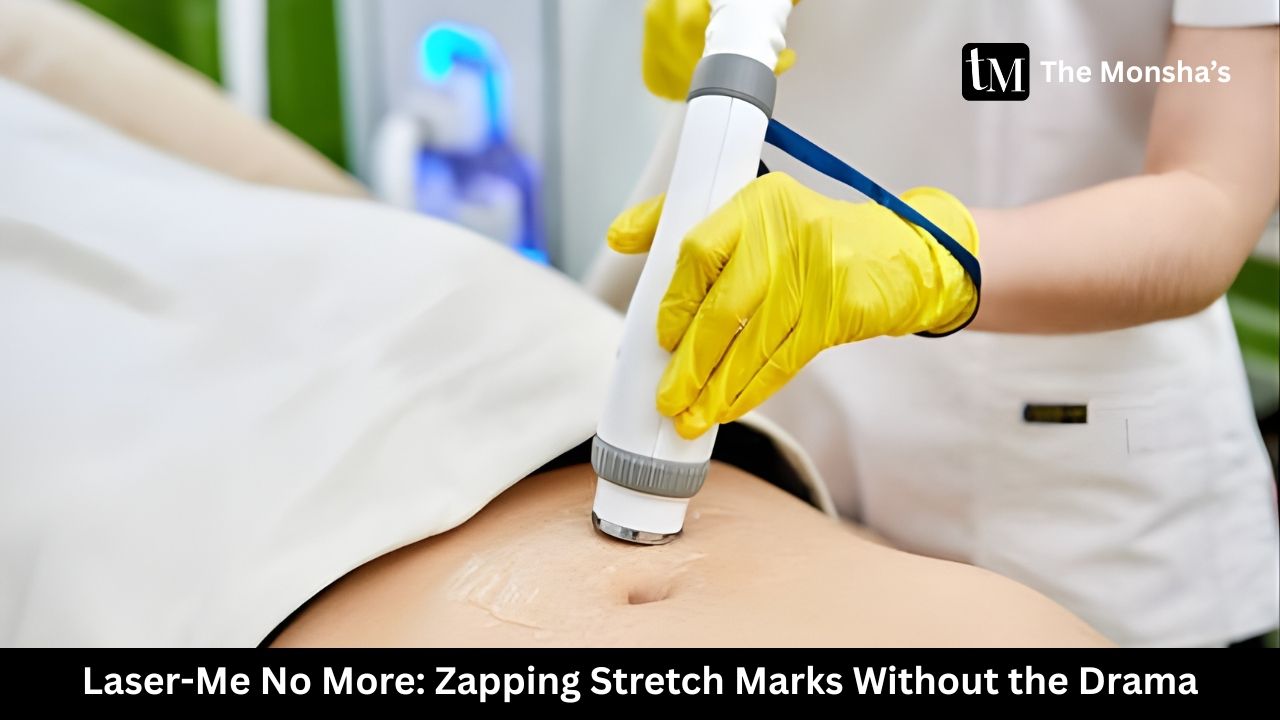“Stretch marks aur main ek doosre ke saath lockdown mein hi chipak gaye… aur tab se chhodne ka naam hi nahi le rahe. 🎵“Mark ko koi zara zapping kare…” — bas yeh remix hai stretch-free skin ka!” 😅
TL;DR — Lasers Can Fade, Smooth & Boost Confidence (But Not Magic Erasers)
- Stretch marks = dermal tears, collagen & elastin breakdown
- Modern lasers stimulate new collagen & elastin to remodel skin texture
- Fractional CO₂, non-ablative fractional, picosecond & hybrid lasers show best evidence
- Combine lasers with microneedling, PRP, retinoids + strict sun care for best results
- Always choose an experienced dermatologist & realistic expectations
What Are Stretch Marks & Why They Stick Around
Stretch marks (aka striae distensae) are basically scars in your dermis where collagen and elastin snapped under pressure — pregnancy, rapid weight changes, growth spurts, hormonal shifts. They start red/purple (striae rubrae) and later become white/silver (striae albae) as blood vessels shrink.
Why topicals rarely erase them? Because the damage is deep. Creams may help texture and color a bit, but the torn dermis needs stimulation to rebuild — that’s where lasers come in.
How Lasers Work on Stretch Marks (The Science Behind It)
Lasers create controlled micro-injuries in the dermis. This triggers wound healing, fibroblasts, and new collagen + elastin production — like a gentle reboot of your skin’s support system.
- Ablative lasers (CO₂, Er:YAG): vaporize columns of tissue to resurface deeply
- Non-ablative fractional lasers: heat under the skin without breaking the surface
- Picosecond lasers: ultra-short bursts = less heat, more safety
- Hybrid / stacked: combine ablative & non-ablative or microneedling/PRP for synergy
Dermatology papers show improved texture, color and patient satisfaction after multiple sessions, especially in newer marks.
Laser Technologies for Stretch Mark Removal
Fractional CO₂ & Er:YAG Lasers (Ablative)
- Deepest collagen remodeling
- More downtime (redness, peeling 5-7 days) but strong effect on older white marks
- Cooling tips, advanced scanners reduce risk
Non-Ablative Fractional Lasers (1540/1550 nm)
- Gentler, safe for darker skin tones
- Gradual improvement, minimal downtime
- Works better on newer red marks
Picosecond Lasers
- Energy in trillionths of a second — less thermal injury
- Better safety profile for Indian skin
- Fewer sessions vs older Q-switch tech
Hybrid & Combination Protocols
- Combining CO₂ + non-ablative fractional for stubborn marks
- Adding microneedling + PRP post-laser to accelerate healing
- New devices allow switching wavelengths in one handpiece
Choosing the Right Laser — Decision Matrix

Risks, Side Effects & What Can Go Wrong
Let’s be honest: lasers aren’t magic wands. Potential pitfalls:
- Post-inflammatory hyperpigmentation (PIH) — especially in Indian skin if energy too high
- Hypopigmentation — white spots if overtreated
- Scarring or burns — poor technique
- Worsening marks — if aftercare neglected
Safety tips: always do a patch test, follow strict sun avoidance, moisturise generously, and stick to prescribed aftercare.
Smart Protocols: Laser + Maintenance for Best Results
Most derms use a combo approach:
- Microneedling or RF microneedling between laser sessions
- PRP (platelet-rich plasma) to speed up healing
- Topical retinoids & peptides to keep stimulating collagen
- Strict sun protection & gentle skincare (tinted SPF, no harsh scrubs)
Real example: A 30-year-old postpartum patient achieved >60% texture improvement after 4 fractional CO₂ sessions combined with PRP and topical retinoids, with minimal PIH.
Case Stories That Inspire
One patient with teenage growth-spurt marks used picosecond laser + microneedling and saw noticeable fading in 3 sessions. Another with older silver marks opted for CO₂ fractional + PRP and achieved smoother texture but needed more downtime.
What To Ask Your Dermatologist / Clinic Before You Laser
- Which laser(s) do you recommend for my mark type & skin tone?
- How many sessions? Spacing? Cost?
- Expected downtime & aftercare?
- Before/after pictures of similar cases?
- Maintenance plan?
- Patch test policy?
If a clinic says “one session and gone” — run. 🏃♀️
FAQs — Stretch Mark Laser Edition
Q1. Will laser completely erase my stretch marks?
No — it fades, smooths and improves texture, but cannot fully erase.
Q2. How many sessions will I need?
Typically 3–6 sessions, depending on mark age, color, and your skin.
Q3. Is laser painful?
Feels like hot snaps; numbing cream + cooling devices help.
Q4. Is it safe for darker Indian skin?
Yes, with the right laser, low settings, and experienced hands.
Q5. Can pregnant or breastfeeding women get laser?
Usually postponed; consult your doctor.
Conclusion: The Stretch Mark Gyaan Recap
Lasers can be life-changing for stretch marks — but only with right tech, right settings, right hands. Combine them with complementary therapies and disciplined aftercare for your best shot at smoother skin.
“Na cream, na conceal… laser hi kare feel!” 😎
📞 Want pro-approved skin services at home? Book your glow ritual with The Monsha’s – Salon at Home Services today.Visit www.themonshas.com or call 9599470951 to bring expert care right to your door.

